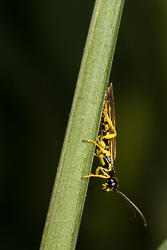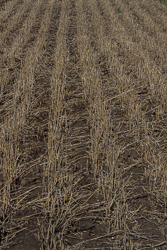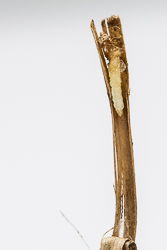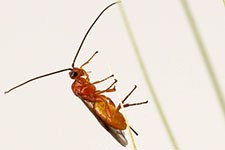| |
2019 Wheat Stem Sawfly Forecast | |
| |
|
|
| |
|
|
| |
 |
 . .
| The sawfly conducted in the fall of 2018 clearly shows an increasing population in various parts of southern Alberta. On the other hand the population of central Alberta (Camrose, Beaver and Flagstaff and Paintearth counties) has completely collapsed and shows no evidence of recovery. Increased levels sawfly damage were found in Vulcan, Foothills and Newell counties. The M.D. of Acadia, Special Areas 3 and Forty Mile County all experienced increasing wheat stem sawfly populations in 2018 as well.
Field locations denoted by a black dot had zero sawfly found in the survey.
The damage ratings are based on 103 fields in 22 municipalities.
pdf of the Wheat Stem Sawfly Map. |
Nine years of sawfly survey at a glance
The Wheat Stem Sawfly Map is based on cut stem counts conducted in the fall of 2018 . In each field the number of wheat stem sawfly cut and the number of uncut stems are determined in a one meter of stubble in 4 locations. Overall the sawfly risk remains lower than the outbreak levels of the early 2000’s but the increase sawfly damage in many spots of southern Alberta signals a resurgence due to the dryer conditions over the past few years. The random nature of the survey means that individual fields may still have higher wheat stem sawfly populations than are indicated in the survey map.

Wheat stem sawfly |
 Wheat stem sawfly damage
Wheat stem sawfly damage |

Wheat stem sawlfy larva in stem |
The percent of stems cut by sawfly gives an indication of the number of reproductive adult sawflies that will emerge in late June through early July. Winter conditions have very little impact on sawfly populations and a high proportion of wheat stems cut in the fall will produce adults. Producers in areas with moderate to high levels of cutting should consider using solid stem wheat as a control strategy
Female sawflies lay eggs inside grass and grassy crop stems; the eggs hatch and tunnel inside stems until the crop starts to dry down near harvest. As the crop starts to ripen the sawfly larva migrates to the stem base and cuts a notch most of the way through the stem. Feeding damage from the tunneling can result in hidden yield losses of 10 to 15 percent. Further yield losses can occur from lodging at harvest. More information can be found at wheat stem sawfly life cycle.
It is possible that population hot spots still exist in areas of lower risk, individual producers need to be aware of the potential risks in their own fields.
Cutting levels higher than 10 to 15 percent or higher in the previous crop year indicate the need to consider seeding solid stem wheat to reduce sawfly losses. It is important farmers evaluate their individual situations in making their variety choices. When populations are low it is typical to have small localized populations of sawfly that affect only one field or even just a portion of one field. At lower populations wheat stem sawfly tends to have a very strong edge effect where they migrate into the current year crop from the previous year stubble.

Bracon cephi | Parasitism can reduce populations and reduce the level of cutting. A parasitic wasp, Bracon cephi, has been shown to have significant impact on sawfly populations.
The use of solid stem wheat varieties and the increase in parasitism are the major factors in lower sawfly populations in Alberta.
|
Frequently Asked Questions
Economic Thresholds
The 2018 wheat stem sawfly survey was carried out by Alberta Agriculture and Forestry with support from Farming Smarter and Chinook Applied Research Association. Thank you for your contribution.
Thank you Jan Lepp, Agriculture and Forestry, Brooks for managing the data from the field sheet to spread sheet.
Thank you David Giffen, Agriculture and Agri-Food Canada, Saskatoon for building the map. |
For more information of sawfly and their management contact the Ag-Info Centre at 310-FARM (3276)
|
|
| |
|
|
| |
For more information about the content of this document, contact Scott Meers.
This document is maintained by Shelley Barkley.
This information published to the web on December 5, 2018.
|
|